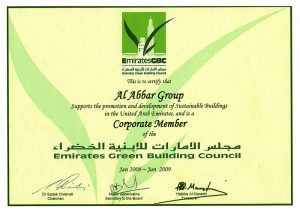 The Al Abbar Group shares the concerns of the Emirates Green Building Council (EGBC) as it joins the council as a corporate member.
The Al Abbar Group shares the concerns of the Emirates Green Building Council (EGBC) as it joins the council as a corporate member.
The central aim of the EGBC is to advance green building principles to achieve high performance buildings that utilize environmentally friendly technologies, critical for protecting the environment and ensuring sustainability in the UAE.
EGBC is a non profit organization, formed in 2006 with the goal of advancing green building principles for protecting the environment and ensuring sustainability in the UAE. It called for breakthrough towards creating and maintaining sustainable Built-environment and protecting the ecosystem in the country, which could serve as a model for the region. This falls in line with recent decisions by the Government that was culminated by signing the Kyoto Protocol and its commitment towards reducing the Carbon emissions in the UAE, through the use of innovative renewable energy and green technologies. Thus, Emirates GBC was formed. The Emirates GBC has been accepted as a full member of the World Green Building Council (World GBC). Current members of World GBC are USA, Canada, Japan, Australia, India, Taiwan, Mexico and the United Arab Emirates.
THE NEED TO BE GREEN Recent statistics published by Ministry of Economy & Commerce showed that Dubai power consumption in 2004 alone was 16,363 Gigawatts-hour of which 70% was utilized in commercial and residential buildings (Source: Gulf News, June 10, 2005). With the skyrocketing construction boom this figure will be increased or may be doubled in the next 5 years thus; clean and renewable energy should be incorporated in buildings to reduce the dependence on the grid and consequently decrease CO2 emission. High-performance Green Buildings are the solution to energy efficient construction, conservation of water, provide healthy indoor environment and improve productivity of occupants. In a more close aspect green Building concept is important at it provide Indoor Environmental Quality (EIQ) notably Indoor Air Quality (IAQ). The U.S. Environmental Protection Agency (EPA) has estimated that the US spends huge amounts in direct medical cost attributable to IAQ. Considering the intensive volume of cooling load the Gulf and particularly in the UAE use to keep buildings cool , IAQ become a vital issue to ensure that healthy environments are kept are highest levels.
This is why the need for sustainability in the UAE is very crucial. HH Sheikh Mohammed bin Rashid Al Maktoum, vice-president and prime minister of the UAE and Ruler of Dubai issued a new resolution on the implementation of green building specifications and standards in the Emirate of Dubai. Effective January 2008, under the new resolution, all owners of residential and commercial buildings and properties in Dubai must comply with internationally recognised environmentally-friendly specifications.
Building sustainability can be accessed through the Leadership in Energy and Environmental Design (LEED) rating system. Developed by US Green Building Council (USGBC), LEED is a voluntary, consensus-based national rating system for developing high performance, sustainable buildings. It addresses all building types and emphasizes state-of-the-art strategies for sustainable site development, water savings, energy efficiency, materials and resources selection and indoor environmental quality. LEED is a certification system that deals with the environmental performance of buildings based on overall characteristics of the project.
‘LEED’ING THE WAY EGBC has launched a proposed building sustainability assessment system for the UAE. The system is based on the US Green Building Council’s (US GBC) Leadership in Energy and Environmental Design (LEED) rating system, with modifications made to account for the local environmental conditions. The proposed LEED Emirates system is currently lodged as a pilot program with the US GBC for evaluation.
The main modifications to the US LEED system include an increased emphasis on water conservation. In addition, adjustments have been made to the content and weight given to other sections to make the overall system more applicable for use in the UAE’s construction sector. The potential total points possible have also been raised from 69 to 72.
A number of assessment methods were considered for the basis of the new rating system, with LEED being selected due to its international recognition. In addition, the system refers to standards that are widely used in the UAE and several LEED accredited buildings already exist in the Emirates, which demonstrated that the model is achievable in the current construction sector.



